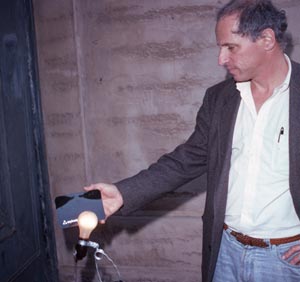How hot is it?

Paul Doherty uses sunlight to warm a liquid crystal
thermometer.
How hot is it?

Paul Doherty uses sunlight to warm a liquid crystal
thermometer.
Introduction
A liquid crystal thermometer shows temperatures as colors. These postcards can be used to compare the energy output of an incandescent lamp to that of the sun.
Material
Assembly
Optional. You do not need an entire postcard for
the experiment, you can cut the postcard into 3 smaller cards they
need to be cut at least 5 cm (2”) on a side.
To slow down the heating of the postcard use spray adhesive to mount
it to a slab of metal.
To Do and Notice
Place all postcards in the shade. The postcards should start out by being black.
Move a postcard into direct sunlight quickly. Hold the card perpendicular to a line pointing to the sun.
The card will warm up turning first red then
yellow, green, blue and black again.
Time how long it takes from the first appearance of red to the last
disappearance of blue in the center of the card.
Repeat the experiment using another card.

Turn on a 200 Watt light.(In the shade)
Hold the card 10 cm from the bulb and time how long it takes from the
first appearance of red to the last disappearance of blue in the
center of the card.
Be sure to hold the card to the side of the lamp so that is it heated
only by radiation, not by convection.
Find the distance you must hold the card from the lightbulb so that
it takes the same amount of time to change colors as the card held in
the sun. Measure the distance from the center of the lightbulb to the
card.
Notice that the card is much closer to the lightbulb than to the sun
when it takes the same amount of time to change
temperatures.
What’s Going On?
When it takes the same amount of time to change
the temperature of the card with the lightbulb as with the sun, then
the same amount of energy is flowing into the card from the lightbulb
as is flowing into the card from the sun.
The flow of energy into the card during a time interval is inversely
proportional to the square of the distance from the source of the
energy. We can find the energy output of the sun since we know the
energy flow from the lamp is 200 Watts and we know the distance to
the lamp and the distance to the sun (1.5 x 10
11m). See the math root.
Math Root
The power out of the sun or a spherical lamp bulb spreads over a sphere uniformly. The power does not vanish but simply spreads over larger and larger spheres. The area of a sphere is 4pr2. Thus the power per unit area, P/4pr2, which is what changes the temperature of the postcard, decreases proportional to the inverse square of the distance from the center of the sun or lightbulb.
When the card takes the same amount of time to change through its temperature range then the power per unit area from the lamp is equal to the power per unit area from the sun: In the following example we used 10 cm or 0,1 meter as the distance from the center of the bulb to the card.
Power of lamp/distance to lamp2 = power of sun/distance to sun2
Plamp/D2lamp=
Psun/D2sun
or
Psun = PlampD2sun/D2lamp
= 200 W (1.5 x 1011)2/(0.1)2
= 4x 1026 W
The actual power output of the sun is 4 x 1026 Watts.
Etc
If you compare the light output of the sun to that of a 200 Watt lightbulb, using a grease spot photometer, then you will find a different distance at which the light intensities balance than at which the total energy outputs balance. This is because the sun is hotter than the lightbulb. (Bulb filament temperature is 2800 K while sun temperature is 5800 K.) Hotter objects put out a smaller fraction of their radiation in the infrared. So the lightbulb puts out proportionally more infrared and less visible light than does the sun. In our experiments, in California in early spring, the light from the 200 Watt lamp balanced the light from the sun at 10 cm while the total power output at all wavelengths of the lamp balanced that of the sun at 20 cm.
|
Scientific Explorations with Paul Doherty |
|
5 Nov 99 |